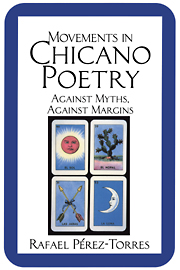8 - Between Worlds
Published online by Cambridge University Press: 17 September 2009
Summary
Borders don't apply now.
East L.A. is everywhere.
– GronkThird World, First World, Fifth World – each mythical constellation offers a prime way to consider Chicano literature. Each promises an insight into the workings of this conflicted literary product. By imposing a matrix, each delimits the potential significance of an obviously complex aesthetic expression. The present study has examined some critical frameworks by which to consider Chicano poetry as an active participant in contemporary American culture. Critical approaches to this border culture – comprised as it is of numerous sites and intense tensions – here crystallize around discussions of postcoloniality and postmodernity. Whereas I have sought to explore the benefits the conceptualizations “postcolonial” and “postmodern” bring to the study of Chicano literature – a project undertaken without apology, as I said – I must admit that I remain suspicious of an easy schematization. It bears emphasizing that neither Chicano poetry, postcolonial discourse, nor postmodernism are coterminous. They are cultural formations at play within a highly contentious historical field marked and marred by the exploitation confronting Mexican people in the United States. The name of the field, of course, is the borderlands.
The borderlands remain a site of rupture: economic disempowerment, racial categorization, sexual stratification, cultural marginalization. Against these ruptures Chicana culture constructs strategies of empowerment and affirmation. Consequently, the tensions explored in this book between the terms “postcolonial,” “postmodern,” and “Chicana” result in part from the fact that the Chicana maintains both the colonial and the modern within its cultural configurations.
- Type
- Chapter
- Information
- Movements in Chicano PoetryAgainst Myths, against Margins, pp. 245 - 272Publisher: Cambridge University PressPrint publication year: 1995

